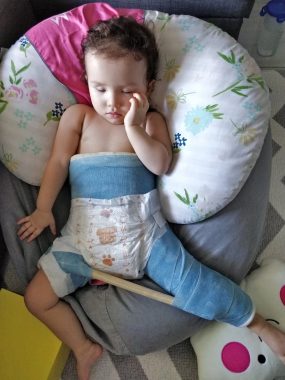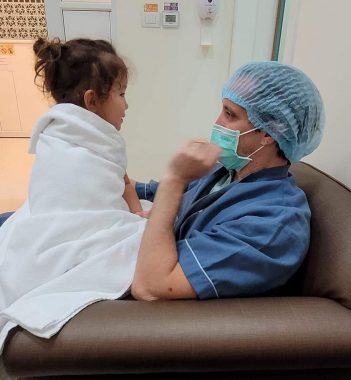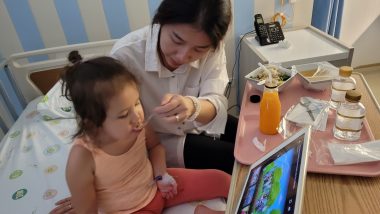After Gene Therapy, Hospitalizations Are Smoother for My Daughter

Since our family’s first trip to the hospital on that dark and rainy night a few years ago, hospitalizations have always been challenging.
Our daughter, Rylae-Ann, who turned 4 this month and has aromatic l-amino acid decarboxylase (AADC) deficiency, would scream and grow tense with anxiety and fear when we’d have to take her to the hospital. Treatment became tricky, so the doctor’s solution was to sedate her. Hospitalizations were longer than expected due to her weak lungs and muscles and other factors.
Eventually, Rylae-Ann had gene therapy as part of a clinical trial in November 2019, but we weren’t sure what the results would be. We focused on her movement, but how would she cope in the future with hospitals, surgery, and recovery? Would the benefits of gene therapy extend to future hospitalizations?
Hip surgery
About six months after Rylae-Ann had gene therapy, we scheduled her for surgery to correct a dislocated hip. The hip socket never formed correctly because her hip joint probably became dislocated early on due to frequent oculogyric crises and intense dystonia.
We wanted to have the surgery as soon as possible. The doctor explained that the earlier her hip was corrected, the more likely she would fully recover. However, we felt dejected because we wouldn’t be able to immediately take full advantage of the results of gene therapy. Rylae-Ann would need to first correct her hip and then be in a spica cast for three months while waiting for the grafted hip bone to form.
The surgery in June 2020 went well, but she was hospitalized for a few days to recover from the anesthesia. After surgery, she ran a high fever for four days, which worried us. But after a week, she was better and began adapting to her life in the cast.

Rylae-Ann rests in a spica cast after having hip surgery in June 2020. She wore the cast for three months. (Photo by Richard E. Poulin III)
Pins still in
After three months in the spica, Rylae-Ann was finally freed. She began by crawling, then standing, and eventually walking. Nearly a year passed, but Kirschner wires, also known as K-wires or pins, remained in her hip bone.
We didn’t want to remove them immediately as we hoped to travel to do it, because our employer-sponsored insurance in Singapore didn’t cover the surgery, cast, or removal of the pins. Also, the doctor said they weren’t causing any harm, so there was no rush.
Fast forward to this month, and Rylae-Ann is now running, swimming, and riding horses. However, it was time to remove the pins. Now living in Thailand, we pay for medical treatment out of pocket, but healthcare here is affordable.
We scheduled her surgery to remove the pins during the week-long Thai holiday of Songkran last week so that we’d have 10 days off work to dedicate to her recovery.

Before surgery last week to remove pins from her hip bone, Rylae-Ann and her dad have one more talk about what to expect. (Photo by Richard E. Poulin III)
Pin removal
We arrived at the hospital at 6 a.m. Rylae-Ann had just woken and couldn’t have anything by mouth until after surgery. We had talked with her about the surgery the previous week. This paid off because she was calm and happy the entire time — something totally out of character.
The nursing staff let me gown up with her so I could go into the operating room. Still, she remained calm and smiling and said hello to the nurses in Thai.
The anesthesiologist carefully placed a mask over her nose and mouth and told her to count to 10. Rylae-Ann didn’t resist. Although I could see the worry in her eyes, she did as the doctor said and began to count. When she reached 10, she said, “Good night,” and closed her eyes.

Rylae-Ann recovers in the observation room, where her parents can see her, after having pins removed from her hip. (Photo by Richard E. Poulin III)
Recovery
Now we had to wait. I was worried about the anesthesia, but that went smoothly. So far, everything was great. Rylae-Ann came out of the operating room in less than an hour and was kept for observation.
She was groggy, and I knew sleeping would help her to recover. After 30 minutes, the nurses transferred her to the patient room where she could recover, and so could we.
We had a two-hour nap until Rylae-Ann shot up and coaxed us awake. She hopped out of bed and asked to go to the potty. Just then, a nurse walked in and scolded me about letting Rylae-Ann get up. She urged me to make Rylae-Ann get back in bed.
Try as I might, though, this girl was not going back down. We were able to woo her to sit somewhat still using an iPad, but she was still up and moving. The doctor had initially scheduled us to stay for two nights because of her history and condition, but it turned out that wouldn’t be necessary.
We checked out that day and were back home by the late afternoon. As Rylae-Ann walked in the house, she ran to her toy room and was back to normal.

Rylae-Ann eats her first meal after surgery while watching her favorite show on an iPad. (Photo by Richard E. Poulin III)
Results
It was amazing how quickly Rylae-Ann recovered after this hospitalization. She has been post-op for three days at the time of this writing, and her walking looks as stable as ever. She seems to be more active and has a wider range of movement, something even family and friends have noticed.
It feels great to close this chapter of medical treatments for my daughter. She is now entirely post-gene therapy and is still making significant progress. The results of gene therapy to treat AADC deficiency will vary for each child, but it was wonderful knowing that her anxiety about hospitals has eased, and her ability to recover has substantially increased after having the treatment.

Rylae-Ann pushes a doll stroller on the same day she had pins removed from her hip. (Photo by Richard E. Poulin III)
Note: AADC News is strictly a news and information website about the disease. It does not provide medical advice, diagnosis, or treatment. This content is not intended to be a substitute for professional medical advice, diagnosis, or treatment. Always seek the advice of your physician or other qualified health provider with any questions you may have regarding a medical condition. Never disregard professional medical advice or delay in seeking it because of something you have read on this website. The opinions expressed in this column are not those of AADC News or its parent company, Bionews, and are intended to spark discussion about issues pertaining to aromatic l-amino acid decarboxylase deficiency.








Leave a comment
Fill in the required fields to post. Your email address will not be published.